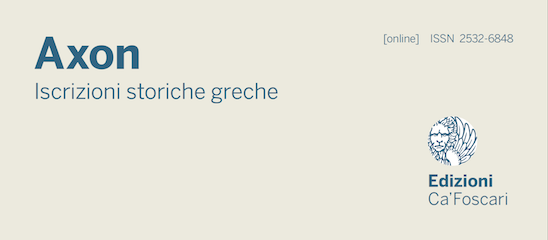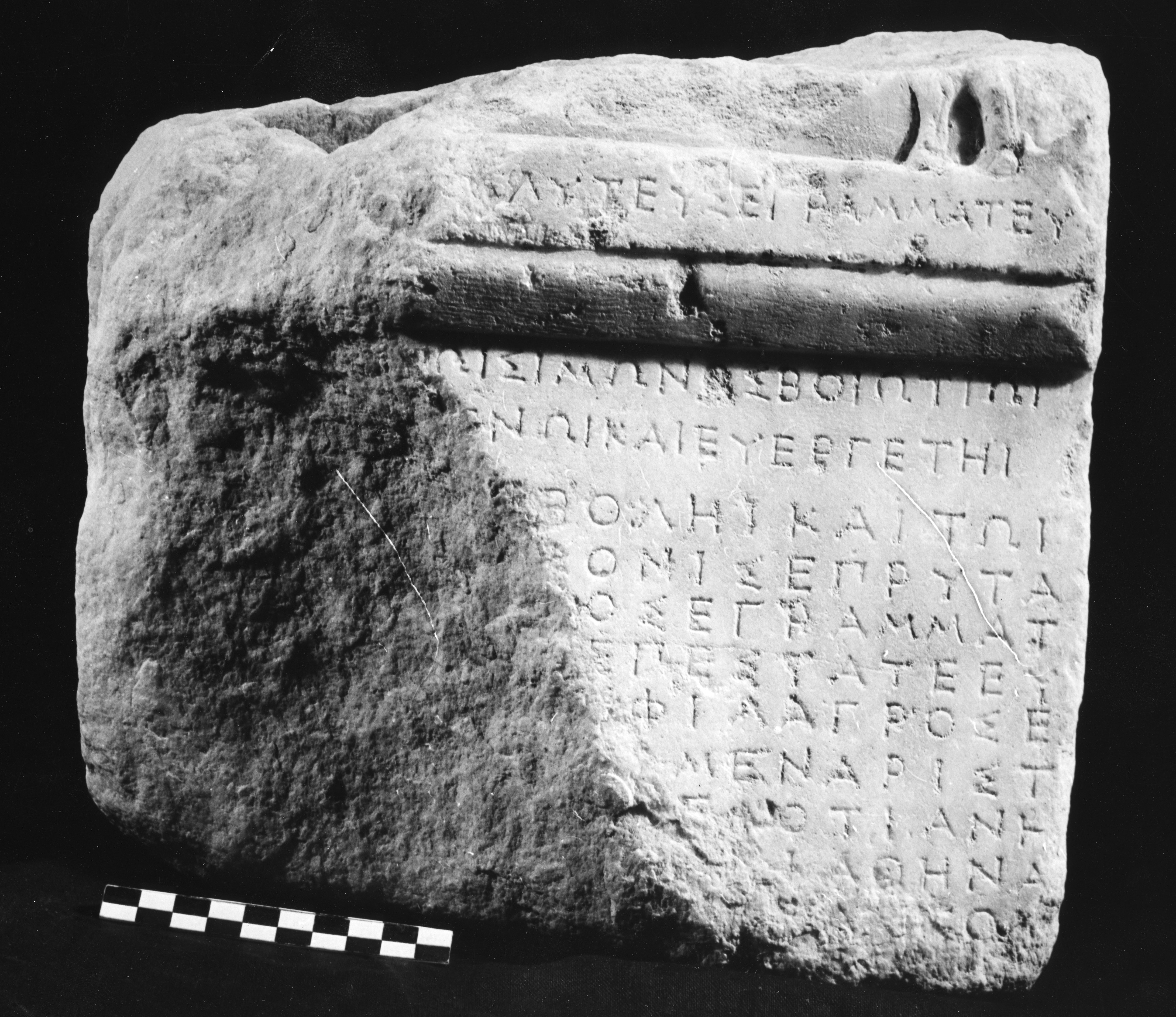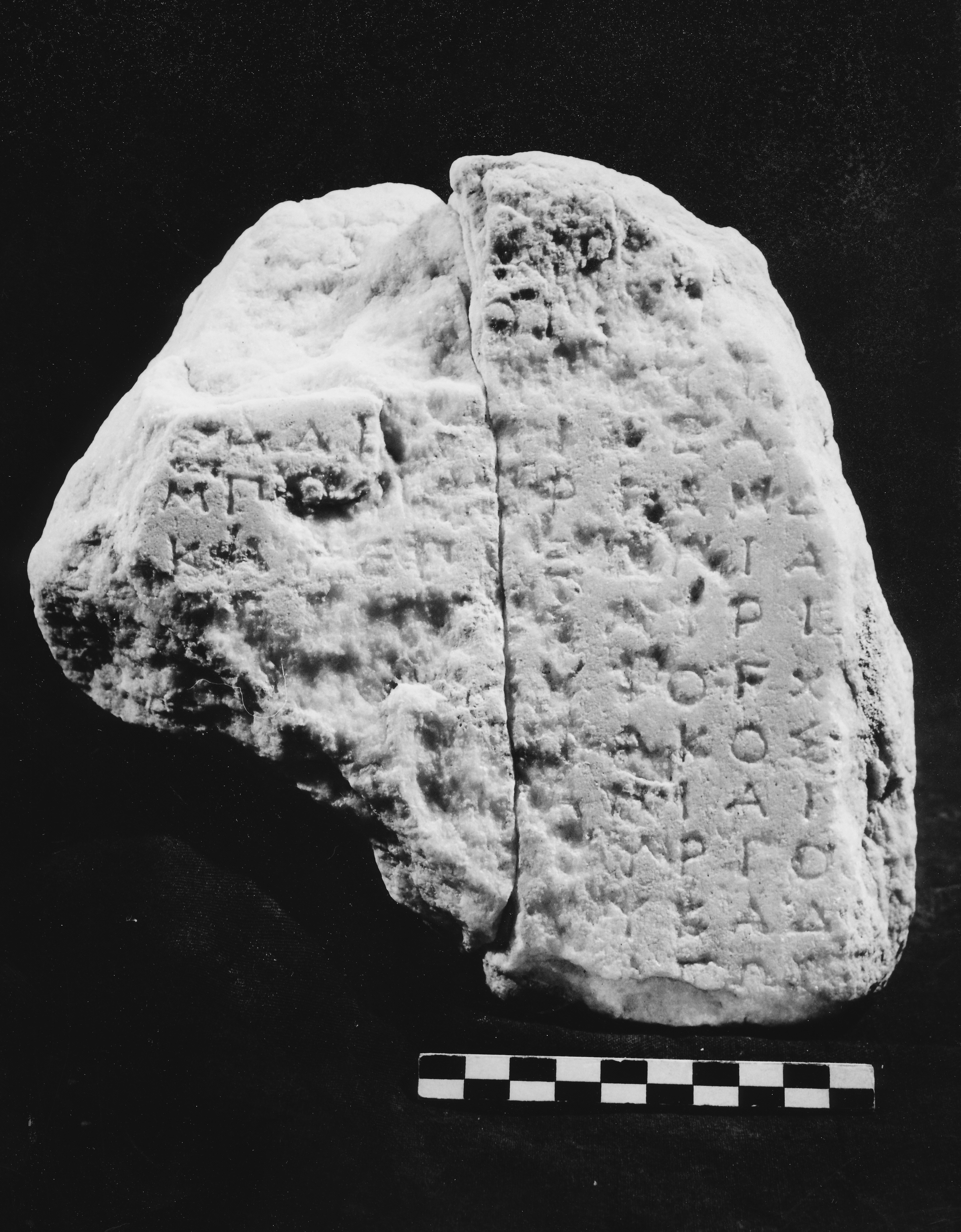I.Eleusis I = Clinton, K. (ed.) (2005). Eleusis. The Inscriptions on Stone. Documents of the Sanctuary of the Two Goddesses and Public Documents of the Deme. I A. Text; I B: Plates. Athens (BAAH n. 236).
I.Eleusis I = Clinton, K. (ed.) (2005). Eleusis. The Inscriptions on Stone. Documents of the Sanctuary of the Two Goddesses and Public Documents of the Deme. I A. Text; I B: Plates. Athens (BAAH n. 236).
IG II.1 = Koehler, U.; Kirchhoff, A. (edd.) (1877). Inscriptiones Graecae. Inscriptiones Atticae aetatis quae est inter Euclidis annum et Augusti tempora Part I. Berlin (nos. 1-641).
IG II.1 = Koehler, U.; Kirchhoff, A. (edd.) (1877). Inscriptiones Graecae. Inscriptiones Atticae aetatis quae est inter Euclidis annum et Augusti tempora Part I. Berlin (nos. 1-641).
IG II[2].1.1 = Kirchner, J. (ed.) (1913). Inscriptiones Graecae. Voll. II et III, Inscriptiones Atticae Euclidis anno posteriores. Part 1, Decrees and Sacred Laws. Fasc. 1. Ed altera. Berlin (nos. 1-1369 in fasc. 1 e 2).
IG II[2].1.1 = Kirchner, J. (ed.) (1913). Inscriptiones Graecae. Voll. II et III, Inscriptiones Atticae Euclidis anno posteriores. Part 1, Decrees and Sacred Laws. Fasc. 1. Ed altera. Berlin (nos. 1-1369 in fasc. 1 e 2).
IG I[3] = Lewis, D.M.; Hallof, K.; Jeffery, L.H.; Erxleben, E. (edd.) (1981-1998). Inscriptiones Graecae. Vol. I, Inscriptiones Atticae Euclidis anno anteriores. Ed tertia. Berlin.
IG I[3] = Lewis, D.M.; Hallof, K.; Jeffery, L.H.; Erxleben, E. (edd.) (1981-1998). Inscriptiones Graecae. Vol. I, Inscriptiones Atticae Euclidis anno anteriores. Ed tertia. Berlin.
Lawton, Reliefs = Lawton, C.L. (1995). Attic Document Reliefs. Oxford.
Lawton, Reliefs = Lawton, C.L. (1995). Attic Document Reliefs. Oxford.
SEG = (1923→) Supplementum Epigraphicum Graecum. Leiden.
SEG = (1923→) Supplementum Epigraphicum Graecum. Leiden.
SEG = Pleket, H.W.; Stroud, R.S. (1985). Supplementum Epigraphicum Graecum (vol. 32). Leiden, Boston.
SEG = Pleket, H.W.; Stroud, R.S. (1985). Supplementum Epigraphicum Graecum (vol. 32). Leiden, Boston.
Veligianni, Wertbegriffe = Veligianni-Terzi, Ch. (1997). Wertbegriffe in den attischen Ehrendekreten der klassischen Zeit. Stuttgart.
Veligianni, Wertbegriffe = Veligianni-Terzi, Ch. (1997). Wertbegriffe in den attischen Ehrendekreten der klassischen Zeit. Stuttgart.
Bruce, I.A.F. (1967). An Historical Commentary on the Hellenica Oxyrhynchia. Cambridge.
Bruce, I.A.F. (1967). An Historical Commentary on the Hellenica Oxyrhynchia. Cambridge.
Carter, D.M. (2004). «Was Attic Tragedy Democratic?». Polis, 21, 1-25.
Carter, D.M. (2004). «Was Attic Tragedy Democratic?». Polis, 21, 1-25.
Cawkwell, G.L. (2010). «Between Athens, Sparta, and Persia: The Historical Significance of the Liberation of Thebes in 379». Nesselrath, H.G. (ed.), Plutarch. On the daimonion of Socrates. Human Liberation, Divine Guidance and Philosophy. Tübingen, 101-10.
Cawkwell, G.L. (2010). «Between Athens, Sparta, and Persia: The Historical Significance of the Liberation of Thebes in 379». Nesselrath, H.G. (ed.), Plutarch. On the daimonion of Socrates. Human Liberation, Divine Guidance and Philosophy. Tübingen, 101-10.
Ceccarelli, P. (2010). «Changing Contexts: Tragedy in the Civic and Cultural Life of Hellenistic City-States». Gildenhard, I.; Revermann, M. (eds.), Beyond the Fifth Century. Interactions with Greek Tragedy from the Fourth Century BCE to the Middle Ages. Berlin, Boston, 99-150.
Ceccarelli, P. (2010). «Changing Contexts: Tragedy in the Civic and Cultural Life of Hellenistic City-States». Gildenhard, I.; Revermann, M. (eds.), Beyond the Fifth Century. Interactions with Greek Tragedy from the Fourth Century BCE to the Middle Ages. Berlin, Boston, 99-150.
Cinalli, A. (2015). Τὰ ξένια. La cerimonia di ospitalità cittadina. Roma.
Cinalli, A. (2015). Τὰ ξένια. La cerimonia di ospitalità cittadina. Roma.
Daverio Rocchi, G. (2002). Senofonte. Elleniche. Milano.
Daverio Rocchi, G. (2002). Senofonte. Elleniche. Milano.
Domingo Gygax, M. (2016). Benefaction and Rewards in the Ancient Greek City. The Origins of Euergetism. Cambridge.
Domingo Gygax, M. (2016). Benefaction and Rewards in the Ancient Greek City. The Origins of Euergetism. Cambridge.
Fossey, J.M. (1985). «Aristoxenos the Boiotian again». LCM, 10(3), 39-40.
Fossey, J.M. (1985). «Aristoxenos the Boiotian again». LCM, 10(3), 39-40.
Gauthier, P. (1985). Les cités grecques et leurs bienfaiteurs. Paris.
Gauthier, P. (1985). Les cités grecques et leurs bienfaiteurs. Paris.
Giannotti, A. (2020a). «Being Good Towards the People or the Democracy? The Formulation of Fifth-Century BCE Honorific Decrees». Mnemosyne, 73, 1-20.
Giannotti, A. (2020a). «Being Good Towards the People or the Democracy? The Formulation of Fifth-Century BCE Honorific Decrees». Mnemosyne, 73, 1-20.
Giannotti, A. (2020b). «Religion, State, and Democracy. A Reappraisal of the 5th-Cent. B.C. Libations to Dionysus in the Theatre Attested in Plut. Cim. 8, 8-9». Historikà, 10, 11-44.
Giannotti, A. (2020b). «Religion, State, and Democracy. A Reappraisal of the 5th-Cent. B.C. Libations to Dionysus in the Theatre Attested in Plut. Cim. 8, 8-9». Historikà, 10, 11-44.
Giannotti, A. (2021). «(Un)Masking the πόλις: The Pre-Play Ceremonies of the Athenian Great Dionysia as Theatrical Performances?». Paillard, E.; Milanezi, S. (eds.), Greek Theatre and Metatheatre: Definitions, Problems, Limits. Berlin, Boston, 29-62.
Giannotti, A. (2021). «(Un)Masking the πόλις: The Pre-Play Ceremonies of the Athenian Great Dionysia as Theatrical Performances?». Paillard, E.; Milanezi, S. (eds.), Greek Theatre and Metatheatre: Definitions, Problems, Limits. Berlin, Boston, 29-62.
Giannotti, A. (c.d.s.). «Spatial Memory and the Public-Announcement Clause: The Case of the Athenian Early Inscribed Public Honours». Berti, I.; Lasagni, C.; Marchiandi, D. (a cura di), Inscribing Space. Topography and Communication in Attic Epigraphy. Alessandria.
Giannotti, A. (c.d.s.). «Spatial Memory and the Public-Announcement Clause: The Case of the Athenian Early Inscribed Public Honours». Berti, I.; Lasagni, C.; Marchiandi, D. (a cura di), Inscribing Space. Topography and Communication in Attic Epigraphy. Alessandria.
Giannotti, A.; Proietti, G. (2021). «Legge di Taso sugli onori ai caduti in guerra e alle loro famiglie». Axon, 5, 123-54.
Giannotti, A.; Proietti, G. (2021). «Legge di Taso sugli onori ai caduti in guerra e alle loro famiglie». Axon, 5, 123-54.
Goldhill, S. (1990). «The Great Dionysia and Civic Ideology». Winkler, J.J.; Zeitlin, F.I. (eds.), Nothing to Do with Dionysos? Athenian Drama in Its Social Context. Princeton, 97-129.
Goldhill, S. (1990). «The Great Dionysia and Civic Ideology». Winkler, J.J.; Zeitlin, F.I. (eds.), Nothing to Do with Dionysos? Athenian Drama in Its Social Context. Princeton, 97-129.
Goldhill, S. (2000). «Civic Ideology and the Problem of Difference: The Politics of Aeschylean Tragedy, Once Again». JHS, 120, 34-56.
Goldhill, S. (2000). «Civic Ideology and the Problem of Difference: The Politics of Aeschylean Tragedy, Once Again». JHS, 120, 34-56.
Hack, H.M. (1978). «Thebes and the Spartan Hegemony, 386–382 B.C». AJPh, 99, 210-27.
Hack, H.M. (1978). «Thebes and the Spartan Hegemony, 386–382 B.C». AJPh, 99, 210-27.
Hammond, N.G.L. (2000). «Political Developments in Boeotia». CQ, 50, 80-93.
Hammond, N.G.L. (2000). «Political Developments in Boeotia». CQ, 50, 80-93.
Hau, L.I. (2016). Moral History from Herodotus to Diodorus Siculus. Edinburgh.
Hau, L.I. (2016). Moral History from Herodotus to Diodorus Siculus. Edinburgh.
Henry, A.S. (1983). Honours and Privileges in Athenian Decrees: The Principal Formulae of Athenian Honorary Decrees. Hildesheim.
Henry, A.S. (1983). Honours and Privileges in Athenian Decrees: The Principal Formulae of Athenian Honorary Decrees. Hildesheim.
Koehler, U. (1871). «Aus der Finanzverwaltung Lykurgs». Hermes, 5, 225.
Koehler, U. (1871). «Aus der Finanzverwaltung Lykurgs». Hermes, 5, 225.
Kumanudes, St.A. (1886). «Ψηφίσματα δύο ἀττικὰ καὶ ἐν ἐπιμέτρῳ ψήφισμα ἐκ Πριήνης». AEph, 4, 215-16. Third series.
Kumanudes, St.A. (1886). «Ψηφίσματα δύο ἀττικὰ καὶ ἐν ἐπιμέτρῳ ψήφισμα ἐκ Πριήνης». AEph, 4, 215-16. Third series.
Lambert, S.D. (2020). Attic Inscription in UK Collections. British Museum. Decrees of the Council and Assembly. AIO Papers (AIUK 4.2).
Lambert, S.D. (2020). Attic Inscription in UK Collections. British Museum. Decrees of the Council and Assembly. AIO Papers (AIUK 4.2).
Lasagni, C. (2004). «I decreti onorifici dei demi attici e la prassi politica delle realtà locali». Culasso Gastaldi, E. (a cura di), La prassi della democrazia ad Atene. Alessandria, 91-128.
Lasagni, C. (2004). «I decreti onorifici dei demi attici e la prassi politica delle realtà locali». Culasso Gastaldi, E. (a cura di), La prassi della democrazia ad Atene. Alessandria, 91-128.
Lewis, D.M.; Stroud, R.S. (1979). «Athens Honors King Euagoras of Salamis». Hesperia, 48, 180-93.
Lewis, D.M.; Stroud, R.S. (1979). «Athens Honors King Euagoras of Salamis». Hesperia, 48, 180-93.
Liddel, P. (2020). Decrees of Fourth-Century Athens (403/2–322/1 BC). Cambridge.
Liddel, P. (2020). Decrees of Fourth-Century Athens (403/2–322/1 BC). Cambridge.
MacDowell, D.M. (2004). «Epikerdes of Kyrene and the Athenian Privilege of Ateleia». ZPE, 150, 127-33.
MacDowell, D.M. (2004). «Epikerdes of Kyrene and the Athenian Privilege of Ateleia». ZPE, 150, 127-33.
Mack, W. (2015). Proxeny and Polis. Institutional Networks in the Ancient Greek World. Oxford.
Mack, W. (2015). Proxeny and Polis. Institutional Networks in the Ancient Greek World. Oxford.
Ma, J. (2016). «The Autonomy of the Boiotian Poleis». Gartland, S.D. (ed.), Boiotia in the Fourth Century B.C.. Philadelphia, 32-41.
Ma, J. (2016). «The Autonomy of the Boiotian Poleis». Gartland, S.D. (ed.), Boiotia in the Fourth Century B.C.. Philadelphia, 32-41.
Matthaiou, A.P. (2010). «The Cutter of IG II2 17: Addenda». Reger, G.; Ryan, F.X.; Winters, T.F. (eds.), Studies in Greek Epigraphy and History in Honor of Stephen V. Tracy. Pessac, 73-81.
Matthaiou, A.P. (2010). «The Cutter of IG II2 17: Addenda». Reger, G.; Ryan, F.X.; Winters, T.F. (eds.), Studies in Greek Epigraphy and History in Honor of Stephen V. Tracy. Pessac, 73-81.
Matthaiou, A.P. (2011). Τὰ ἐν τῆι στήληι γεγραμμένα. Six Greek Historical Inscriptions of the Fifth Century B.C. Athens.
Matthaiou, A.P. (2011). Τὰ ἐν τῆι στήληι γεγραμμένα. Six Greek Historical Inscriptions of the Fifth Century B.C. Athens.
Matthaiou, A.P. (2019a). Ἔξι Ἀττικὲς ἐπιγραφὲς τοῦ 4ου αι. π.Χ. Athens.
Matthaiou, A.P. (2019a). Ἔξι Ἀττικὲς ἐπιγραφὲς τοῦ 4ου αι. π.Χ. Athens.
Matthaiou, A.P. (2019b). «Παρατηρήσεις εἰς ἐκδεδομένα Ἀττικὰ ψηφίσματα (13ο τεῦχος)». ΓΡΑΜΜΑΤΕΙΟΝ, 8, 109-19.
Matthaiou, A.P. (2019b). «Παρατηρήσεις εἰς ἐκδεδομένα Ἀττικὰ ψηφίσματα (13ο τεῦχος)». ΓΡΑΜΜΑΤΕΙΟΝ, 8, 109-19.
McKechnie, P.R.; Kern, S.J. (1988). Hellenica Oxyrhynchia. Oxford.
McKechnie, P.R.; Kern, S.J. (1988). Hellenica Oxyrhynchia. Oxford.
Meriani, A.; Giannattasio Andria, R. (1998). Vite di Plutarco. Torino vol. 6.
Meriani, A.; Giannattasio Andria, R. (1998). Vite di Plutarco. Torino vol. 6.
Muccioli, F.; Ghilli, L. (2001). Plutarco. Lisandro e Silla. Milano.
Muccioli, F.; Ghilli, L. (2001). Plutarco. Lisandro e Silla. Milano.
Pelling, C. (2010). «The Liberation of Thebes in Plutarch’s De genio Socratis and Pelopidas». Nesselrath, H.G. (ed.), Plutarch. On the daimonion of Socrates. Human Liberation, Divine Guidance and Philosophy. Tübingen, 111-28.
Pelling, C. (2010). «The Liberation of Thebes in Plutarch’s De genio Socratis and Pelopidas». Nesselrath, H.G. (ed.), Plutarch. On the daimonion of Socrates. Human Liberation, Divine Guidance and Philosophy. Tübingen, 111-28.
Rhodes, P.J. (1993). A Commentary on the Aristotelian Athenaion Politeia. Oxford.
Rhodes, P.J. (1993). A Commentary on the Aristotelian Athenaion Politeia. Oxford.
Rhodes, P.J. (2003). «Nothing to Do with Democracy: Athenian Drama and the Polis». JHS, 123, 104-19.
Rhodes, P.J. (2003). «Nothing to Do with Democracy: Athenian Drama and the Polis». JHS, 123, 104-19.
Rhodes, P.J. (2011). «The Dionysia and Democracy Again». CQ, 61, 71-4.
Rhodes, P.J. (2011). «The Dionysia and Democracy Again». CQ, 61, 71-4.
Rhodes, P.J. (2016). «Boiotian Democracy?». Gartland, S.D. (a cura di), Boiotia in the Fourth Century B.C.. Philadelphia, 59-64.
Rhodes, P.J. (2016). «Boiotian Democracy?». Gartland, S.D. (a cura di), Boiotia in the Fourth Century B.C.. Philadelphia, 59-64.
Shear, J.L. (2011). Polis and Revolution. Responding to Oligarchy in Classical Athens. Cambridge.
Shear, J.L. (2011). Polis and Revolution. Responding to Oligarchy in Classical Athens. Cambridge.
Sherman, C.L. (1952). Diodorus of Sicily. The Library of History (Books XV.20–XVI.65). Cambridge, Mass.; London.
Sherman, C.L. (1952). Diodorus of Sicily. The Library of History (Books XV.20–XVI.65). Cambridge, Mass.; London.
Spineto, N. (2005). Dionysos a teatro: il contesto festivo del dramma greco. Roma.
Spineto, N. (2005). Dionysos a teatro: il contesto festivo del dramma greco. Roma.
Tracy, S.V. (2003). «A Major Athenian Letter-Cutter of ca. 410 to ca. 380: The Cutter of IG II2 17». Bakewell, G.W.; Sickinger, J.P. (a cura di), Gestures. Essays in Ancient History, Literature, and Philosophy Presented to Alan L. Boegehold. , 351-63.
Tracy, S.V. (2003). «A Major Athenian Letter-Cutter of ca. 410 to ca. 380: The Cutter of IG II2 17». Bakewell, G.W.; Sickinger, J.P. (a cura di), Gestures. Essays in Ancient History, Literature, and Philosophy Presented to Alan L. Boegehold. , 351-63.
Tracy, S.V. (2016). Athenian Lettering of the Fifth Century B.C. The Rise of the Professional Letter Cutter. Berlin, Boston.
Tracy, S.V. (2016). Athenian Lettering of the Fifth Century B.C. The Rise of the Professional Letter Cutter. Berlin, Boston.
Walbank, M.B. (1982). «An Athenian Decree Reconsidered: Honours for Aristoxenos and Another Boiotian». EMC, 26, 259-74.
Walbank, M.B. (1982). «An Athenian Decree Reconsidered: Honours for Aristoxenos and Another Boiotian». EMC, 26, 259-74.
Whitehead, D. (1993). «Cardinal Virtues: The Language of Public Approbation in Democratic Athens». C&M, 44, 37-75.
Whitehead, D. (1993). «Cardinal Virtues: The Language of Public Approbation in Democratic Athens». C&M, 44, 37-75.
Wickersham, J.M. (2007). «Spartan Garrisons in Boeotia 382–379/8 B.C». Historia, 56, 243-6.
Wickersham, J.M. (2007). «Spartan Garrisons in Boeotia 382–379/8 B.C». Historia, 56, 243-6.
Wilhelm, A. (1889). «Attische Psephismen». Hermes, 24, 108-52.
Wilhelm, A. (1889). «Attische Psephismen». Hermes, 24, 108-52.
Wilson, P. (2009). «Tragic Honours and Democracy: Neglected Evidence for the Politics of the Athenian Dionysia». CQ, 59, 8-29.
Wilson, P. (2009). «Tragic Honours and Democracy: Neglected Evidence for the Politics of the Athenian Dionysia». CQ, 59, 8-29.
Wilson, P.; Hartwig, A. (2009). «IG I3 102 and the Tradition of Proclaiming Honors at the Tragic Agon of the Athenian City Dionysia». ZPE, 169, 17-27.
Wilson, P.; Hartwig, A. (2009). «IG I3 102 and the Tradition of Proclaiming Honors at the Tragic Agon of the Athenian City Dionysia». ZPE, 169, 17-27.
Wilhelm, A. (1889). «Attische Psephismen». Hermes, 24, 108-52.
Wilhelm, A. (1889). «Attische Psephismen». Hermes, 24, 108-52.
Wilhelm, A. (1889). «Attische Psephismen». Hermes, 24, 108-52.
Walbank, M.B. (1982). «An Athenian Decree Reconsidered: Honours for Aristoxenos and Another Boiotian». EMC, 26, 259-74.
Wilhelm, A. (1889). «Attische Psephismen». Hermes, 24, 108-52.
Walbank, M.B. (1982). «An Athenian Decree Reconsidered: Honours for Aristoxenos and Another Boiotian». EMC, 26, 259-74.
Fossey, J.M. (1985). «Aristoxenos the Boiotian again». LCM, 10(3), 39-40.
Wilson, P.; Hartwig, A. (2009). «IG I3 102 and the Tradition of Proclaiming Honors at the Tragic Agon of the Athenian City Dionysia». ZPE, 169, 17-27.
Matthaiou, A.P. (2019b). «Παρατηρήσεις εἰς ἐκδεδομένα Ἀττικὰ ψηφίσματα (13ο τεῦχος)». ΓΡΑΜΜΑΤΕΙΟΝ, 8, 109-19.
Wilhelm, A. (1889). «Attische Psephismen». Hermes, 24, 108-52.
IG II.1 = Koehler, U.; Kirchhoff, A. (edd.) (1877). Inscriptiones Graecae. Inscriptiones Atticae aetatis quae est inter Euclidis annum et Augusti tempora Part I. Berlin (nos. 1-641).
Walbank, M.B. (1982). «An Athenian Decree Reconsidered: Honours for Aristoxenos and Another Boiotian». EMC, 26, 259-74.
Koehler, U. (1871). «Aus der Finanzverwaltung Lykurgs». Hermes, 5, 225.
Walbank, M.B. (1982). «An Athenian Decree Reconsidered: Honours for Aristoxenos and Another Boiotian». EMC, 26, 259-74.
Matthaiou, A.P. (2019b). «Παρατηρήσεις εἰς ἐκδεδομένα Ἀττικὰ ψηφίσματα (13ο τεῦχος)». ΓΡΑΜΜΑΤΕΙΟΝ, 8, 109-19.
Koehler, U. (1871). «Aus der Finanzverwaltung Lykurgs». Hermes, 5, 225.
Walbank, M.B. (1982). «An Athenian Decree Reconsidered: Honours for Aristoxenos and Another Boiotian». EMC, 26, 259-74.
Walbank, M.B. (1982). «An Athenian Decree Reconsidered: Honours for Aristoxenos and Another Boiotian». EMC, 26, 259-74.
Wilhelm, A. (1889). «Attische Psephismen». Hermes, 24, 108-52.
Walbank, M.B. (1982). «An Athenian Decree Reconsidered: Honours for Aristoxenos and Another Boiotian». EMC, 26, 259-74.
Wilson, P.; Hartwig, A. (2009). «IG I3 102 and the Tradition of Proclaiming Honors at the Tragic Agon of the Athenian City Dionysia». ZPE, 169, 17-27.
Walbank, M.B. (1982). «An Athenian Decree Reconsidered: Honours for Aristoxenos and Another Boiotian». EMC, 26, 259-74.
| 

















